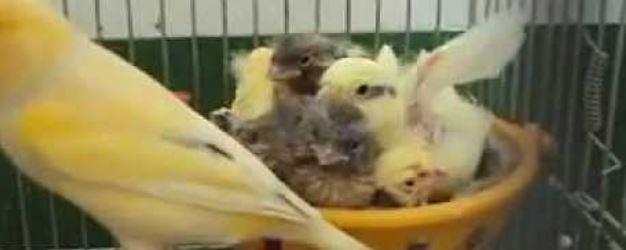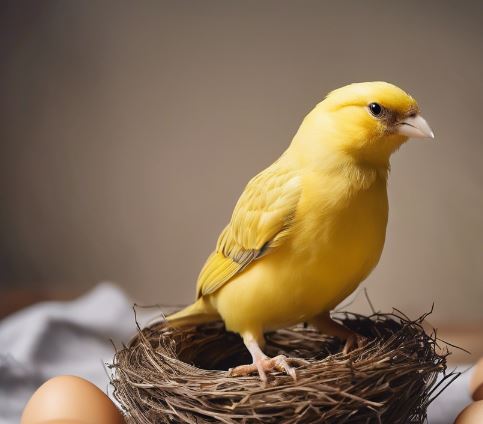Choosing and Using the Right Canary Nest For Your Birds
When choosing a canary nest for your breeding canaries consider your options, nest placement, and use of nesting materials.
 Canary Nest
Canary NestCreating a comfortable and safe nesting environment is essential for the well-being of your pet canaries, whether you're a seasoned breeder or a new bird owner.
Let's delve into the fascinating world of breeding canaries and canary nests, exploring the importance of proper nesting materials, different types of nests, and tips for creating the perfect nesting environment for your feathered friends.
Whether you're preparing for the breeding season or simply want to provide your canaries with a cozy retreat, join us as we uncover the secrets to successful nesting for these delightful avian companions.
CANARY NEST OPTIONS
In the world of canary bird nests you primarily have 4 choices in construction materials...Bamboo, Sticks, Plastic, and Metal.
I have used both bamboo and plastic but have not had the opportunity to try metal or stick.
My assumption is that if my canaries were to choose, they would choose the one that is most like the nests built by wild canaries in the Canary Islands and that is the stick or bamboo nests.
The plastic nest, however,
is much easier to clean than bamboo and will last a lot longer.
And cleanliness is important. The hen and babies will poop in and around the edges of the nest. Keep it clean and keep your birds healthy.
It may cost you a little more than the bamboo nest but the plastic nests will save money in the long run.
FREE Email Course.
Sign up below and get the 5 part email course: "The #1 Problem You Will Face As A Canary Owner"
NESTING MATERIALS
Canary birds are meticulous nest builders, and they use a variety of natural and artificial materials to construct their nests.
- Soft Fibers: Canary birds may also collect soft fibers, such as cotton or wool, to add warmth and cushioning to their nests. These materials are often used as nesting lining to provide extra comfort for eggs and chicks.
- Feathers: Canaries may incorporate feathers into their nests, both for insulation and as a decorative element. Feathers help regulate temperature and humidity within the nest and can also provide additional padding for eggs and chicks.
- Commercial Nesting Materials: In addition to natural materials, there are also commercial nesting materials available specifically for birds, including canaries. These materials are often made of shredded paper, coconut fiber, or other safe and non-toxic materials designed to mimic natural nesting materials.
It's essential to provide a variety of nesting materials for your breeding canaries to choose from, allowing them to select the materials that best suit their preferences and nesting instincts.
Ensure that all materials are clean, dry, and free from pesticides or other contaminants to promote the health and safety of your birds. By offering a diverse selection of nesting materials, you can help create a comfortable and inviting nesting environment for your canaries to thrive.
Nesting materials for breeding canaries can include a nest liner usually made of cotton or felt. Liners are not absolutely necessary but sometimes hens are just not very good at building a quality canary nest and need a bit of help. Liners provide that help.
Also...
- gunny sack fibers
- small pieces of soft cloth
- coconut fibers
- sisal fibers
- thick cotton string (not fine thread)
- bathroom tissue (unscented)
When using gunny sack, cut it into 2 inch squares and pull out the individual strings. Place in the cage.
You can take a roll of bathroom tissue that is almost used up. Tie a string around it so it can't unroll and place in the cage or tie to the outside of the cage. Your canary will have fun tearing off bits for her nest. In fact...
...even if you have no intention of breeding canaries I suggest providing nesting material of some kind in the cage (like the items below) so your canary bird has something to play with. Canaries like to pick things up and carry it around so it's just another part of providing good canary care and making sure your bird doesn't get bored.
Of course, cutting up nesting materials can be time consuming. Thankfully online stores usually carry nests and prepared nesting materials.
PLACEMENT OF THE CANARY NEST
Placement of a canary nest within the cage is crucial for the comfort and safety of your pet birds. Here are some tips for proper nest placement:
- Low and Secure: Position the nest low within the cage, preferably near the bottom, to mimic the natural nesting habits of canaries. Ensure the nest is securely attached to the cage to prevent tipping or displacement.
- Not Under Perches: Place the nest away from perches and other cage accessories to minimize disturbance and encourage nesting behavior. This creates a secluded and private space for the canaries to build their nest and care for their eggs or chicks.
- In a Quiet Area: Choose a quiet area of the cage for nest placement, on the opposite side of the feeder and waterer, away from high-traffic areas and noisy environments. This reduces stress and disturbance for the nesting pair, allowing them to focus on breeding and parenting duties.
- Accessible for Monitoring: While the nest should be secluded, ensure it is still accessible for monitoring and observation. This allows you to check on the progress of the nesting pair, monitor egg-laying, and assess the health and condition of the eggs or chicks without causing undue disturbance.
- Proper Ventilation: Ensure adequate ventilation around the nest area to maintain air circulation and prevent overheating. Avoid placing the nest in areas with restricted airflow or poor ventilation, as this can lead to heat stress or respiratory problems for the nesting birds.
- Natural Lighting: If possible position the nest in an area of the cage that receives natural light, as this helps regulate the birds' circadian rhythms and promotes healthy breeding behavior. Avoid placing the nest in direct sunlight, however, as this can cause overheating or discomfort for the nesting pair.
By following these guidelines for nest placement, you can create a suitable and comfortable environment for your pet canaries to engage in natural nesting behaviors and successfully raise their young within the confines of their cage.
Place the nest in the cage, attached to the bars, but make sure it is not directly under a perch or near a feeding or water dish.
Your canary bird hen will appreciate a little space of her own. If possible place the nest near a corner. She will feel safest here.
Be careful...don't place the canary nest so high she can't enter and exit easily. Keep the top of the nest at least 4 inches from the top of the cage. This will give her room to go in and out and also enough room to stand up and turn around in the nest.
Obviously, if she looks like she is crowded against the top of the cage move the nest down a bit.
Make sure the canary nest is secure and level. The last thing you want is to have your baby canaries falling to the floor of the cage.

Provide 2 canary nests per pair of breeding canaries. Before the first chicks leave the nest the female may want to begin a new 2nd nest.
Feed your canaries well during breeding time. The hen especially needs lots of nutrients to avoid illness and to produce eggs and care for the babies.
Make sure there are enough nesting materials available for her to build the 2nd nest...otherwise she may pluck feathers from her babies and use that in her 2nd canary nest! OUCH.
Build A Nest
Technically, you can make your own nest out of a lightweight bowl of some kind as this canary nest page suggests.
Just be careful and make sure the nest is full supported so that it doesn't ever sag on one side or fall down.
Finishing Up
Providing your pet canaries with a comfortable and safe nesting environment is crucial for their natural behavior and reproductive success.
By understanding the different types of nests, selecting appropriate nesting materials, and placing the nest properly within the cage, you can create an ideal environment for breeding and nesting activities.
Remember to monitor the nesting pair regularly and provide them with the care and attention they need to thrive.
With the right approach, you can help your canaries engage in natural nesting behaviors and create a cozy home for their future offspring.
Recommended Pet Canary Supplies...
Keep in touch by signing up for the free CanaryTips newsletter.
Click here to learn more.
Return from Canary Nest to Breeding Canaries Main Page.
Have A Great Story or Tip About This Topic?
Do you have a great story or tip about canary health care? Share it! It may be of great interest and assistance to other canary owners.
What Other Visitors Have Said
Click below to see contributions from other visitors to this page...
Outdooor Canaries 




I have a walk-in simple wire enclosed cage apx 5 feet in diameter and 6ft high.
I keep 14 canaries even during the winter in the outside cage and …
















